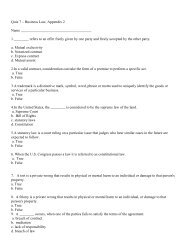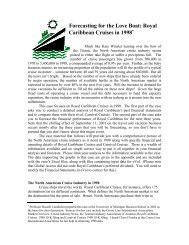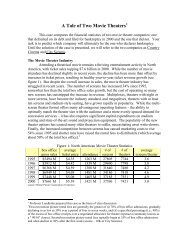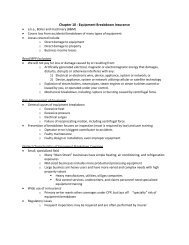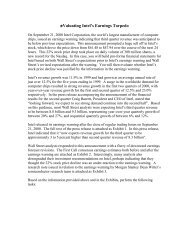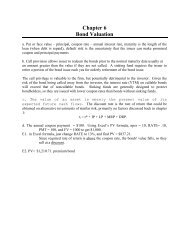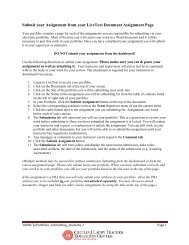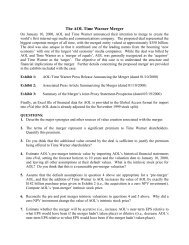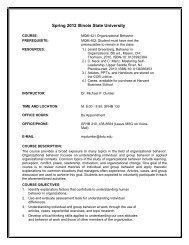Chapter 11 - Life Insurance - Illinois State University
Chapter 11 - Life Insurance - Illinois State University
Chapter 11 - Life Insurance - Illinois State University
Create successful ePaper yourself
Turn your PDF publications into a flip-book with our unique Google optimized e-Paper software.
<strong>Chapter</strong> <strong>11</strong> - <strong>Life</strong> <strong>Insurance</strong>What is the financial impact of premature death on families?How much life insurance does one need?What are the basic types of life insurance policies available?Premature Death (Unexpected) death of a family head with outstanding unfulfilled financial obligationsFinancial Impact of Premature Death on Different Types of Families <strong>Insurance</strong> is justified if others are financially dependent on another’s earningso Restores breadwinner’s earnings Single person Single-parent family Two income earners with children Traditional family Blended family Sandwiched familyDetermining the Amount of <strong>Life</strong> <strong>Insurance</strong> to Own Multiple of earnings is inflexible Three approaches to estimate needs1. The human life value approach2. Needs approach (see exhibit)o Reviews family needs vs. current resources3. Capital retention approacho Does not deplete assetso Reviews shortfall of income producing assetsHuman <strong>Life</strong> Value Approach Estimates the family’s share of breadwinner’s earnings Crudely determines “worth” of a person Disadvantageso May ignore employee benefitso Time value of money (inflation, discounting)Capital retention approach How many assets are needed to produce income? First, establish income goal for survivors Determine net capital available for investmento Sources of capital– Cash, investments, and retirement accounts– <strong>Life</strong> insuranceo But some assets used for immediate cash needs– Emergency fund, debts, final expenses– Net capital produces annual income Income shortfall determines insurance needs
Types of <strong>Life</strong> <strong>Insurance</strong> Two general categorieso Term insurance provide temporary protectiono Cash-value life insurance has a savings component Many variations of both typesTerm <strong>Life</strong> <strong>Insurance</strong> Temporary protection No cash value or savings component Premiums increase with age Most are renewable without evidence of insurability (EOI)o EOI means you don’t have to reapply and meet U/W standards againo Select and ultimate mortality Many can be convertibleo Exchange for a cash-value policy Common Term <strong>Life</strong> <strong>Insurance</strong> Policieso Yearly-renewable term (YRT)o Multi-year term insurance have level premiums– 5-, 10-, or 20-year– Term-to-65o Decreasing term insuranceo Reentry term insurance policy requires insured to demonstrate EOI– If not met, premiums increaseo Return of premiums termUses and Limitations of Term <strong>Life</strong> <strong>Insurance</strong> Uses1. Income is limited *2. The need for protection is temporary3. Guarantee future insurability Limitations1. Premiums increase rapidly with age, especially at older ages (60+)2. No cash savings componentWhole <strong>Life</strong> <strong>Insurance</strong> Provides lifetime protection Builds cash value Tremendous variety of product types based on:o Build up of cash valueo Premium adjustments
Ordinary life (straight life) Traditional whole life policy Level-premium, lifetime protectiono Early years’ “excess” premiums build legal reserveso Much more expensive than term insurance Policy builds cash value called cash surrender value (CSV)o Insurer guarantees minimum CSVo Can borrow against CSV or “surrender” policyo Reserves and CSV are related, but NOT the same, especially in early yearsTypes of Whole <strong>Life</strong> <strong>Insurance</strong> Limited-payment life insurance policyo <strong>Life</strong>time death benefit, but premiums ceaseo Policy becomes “paid up”o Extreme form: Single-premium whole life Endowment insurance (no longer popular)o Pays death benefits if insured dieso Pays endowment if insured surviveso Example: Endowment to 65Variations of Whole <strong>Life</strong> <strong>Insurance</strong>: Variable <strong>Life</strong> Fixed premiums, permanent insurance Key component: Death benefit and cash values vary based on the investment experience directed bypolicyholdero “Separate accounts”o There is a minimum death benefit Cash surrender values are not guaranteedo No minimum CSVo Policyholder bears investment riskVariations of Whole <strong>Life</strong> <strong>Insurance</strong>: Universal <strong>Life</strong> Flexible premium policy, lifetime protection “Unbundles” insurance and savings components for policyholder to seeo Premiums get deposited in accounto Decreased by explicit mortality and expense chargeso Increased by explicit interest credits Two optionsA. level death benefitB. level net amount at riskVariations of Whole <strong>Life</strong> <strong>Insurance</strong>: Variable Universal <strong>Life</strong> Universal life (flexible premiums), plus:o Policyowner determines investments (separate accounts) like variable lifeo But no minimum interest guarantee All universal life policies have “high” expenseso Front-end, back-end loadso Mortality, expense, investment, surrender charge
Variations of Whole <strong>Life</strong> <strong>Insurance</strong>: Current assumption whole life Traditional whole life uses conservative assumptionso Low interest guarantees, higher mortality/expenseso May lead to lower cash value CAWL updates assumptions periodically to determines cash values based on current mortality,investment, and expense experienceo Some risk passed to policyholder Most policies have guaranteeso Minimum interest rate, max expenseo Fixed death benefits Two formso Low-premium products, with redeterminationo High-premium products may have vanishing premiumOther Types of <strong>Life</strong> <strong>Insurance</strong> Modified-payment life policyo Premiums are lower initially, higher thereafter Second-to-die life insuranceo Pays death benefit upon death of second insured Group life insurance covers many individuals in a single contracto No separate EOIo Most are term insurance<strong>Chapter</strong> <strong>11</strong> Summary Know the costs of premature to different families Explain different approaches for determining an appropriate amount of life insurance Major distinctions for different types of life insurance<strong>Chapter</strong> 12 - <strong>Life</strong> <strong>Insurance</strong> Contractual ProvisionsWhat are common contractual provisions and clauses of life insurance policies?What options are available for using dividends, surrendering policies, and distributing death benefitsto policyholders?What are common riders?Ownership Issues Ownership clause says the policy “owner” is the one who possesses all contractual rights while theinsured is livingo Naming beneficiaries, surrendering, borrowing against CSV, receiving dividends, etc. Unlike property insurance, life insurance is freely assignable to otherso Absolute assignment transfers all rights to anothero Collateral assignment temporarily transfers certain rights to creditors
<strong>Life</strong> <strong>Insurance</strong> Contractual Provisions: Beneficiary Designation Beneficiary is named to receive policy proceeds Primary beneficiary gets proceeds firsto Contingent beneficiary gets proceeds if primary dies Revocable beneficiary gives owner the right to change the beneficiaryo Irrevocable beneficiary cannot be changed without the beneficiary’s consent Specific beneficiary is identified explicitlyo Class beneficiary is a member of a groupUtmost Good Faith Issues Entire-contract clause states that the policy and application constitute the entire contracto Remember that application statements are representations Incontestable clause says the insurer cannot contest the policy after two years Only when against public interest can the insurer contest a claim after two yearso The beneficiary takes out the policy with the intent of murder the insuredo The applicant has someone else take the medical examo Insurable interest did not exist Suicide clause says if insured commits suicide within two years, only a refund of the premiums ispaid Misstatement of age or sex clause adjusts the death benefitProvisions Related to Keeping the Policy Period Active Owner has a 31 day “grace period” Reinstatement: Owners can reinstate lapsed policy up to 3-5 years, buto EOI is requiredo Overdue premiums are due plus interesto Policy loans must be repaid or reinstatedOther Issues There are very few exclusions in life insurance Policy loans for cash value productso Interest rates typically vary with current rate, but still may be considered “low”o Loans typically reduce dividends and interest credits Automatic premium loan borrows from cash value if premium is not paid on timeDividend Options Participating policies may refund some of the premium if the insurer has good experienceo But there are no guarantees Dividends are not taxable Policyowners have several ways to take dividendso Casho Reduce the next premiumo Accumulate at interest with insurero Paid-up additions optiono Purchase term insurance
Nonforfeiture Options With cash value products, owner pays more than cost of insurance When policyowner decides to surrender the original contract, the payment is known the CSV ornonforfeiture value All states have standard nonforfeiture laws that provide some minimum paymento Usually $0 for first and maybe second year Nonforfeiture optionso Surrender for cash (all benefits cease)o Reduced-paid up insuranceo Extended term insurance (usually the default upon lapse)Settlement Options Policyowner (or beneficiary) can choose among several options for paying the policy proceedso Lump sumo Interest option with withdrawal rightso Fixed-period option pays a fixed annuityo Fixed amount optiono <strong>Life</strong> income option pays a life annuity– May have guaranteed period/amount (ch. 14)– Joint and survivor incomeSettlement Options: Comments <strong>Insurance</strong> windfall may create problems settlement options allow for periodic payments to thefamily, restoring financial securityo Insurer guarantees principal and interest Disadvantages include:o Interest rates may not be competitiveo May be inflexible and restrictiveAdditional <strong>Life</strong> <strong>Insurance</strong> Benefits Available for an additional premium Waiver-of-premium (WOP) provisiono Pays premiums if the insured becomes totally disabledo Definition of total disability varies Guaranteed purchase optiono Can purchase additional insurance at specified times in the future without EOI Accidental death benefit rider doubles the face amount (double indemnity) Cost-of-living rider allows owner to purchase one-year term insurance equal to inflation Accelerated death benefits rider allows terminally ill insureds to collect benefits Viatical settlement is the sale of a life insurance policy to another party to receive proceeds A life settlement is the sale of a life insurance policy<strong>Chapter</strong> 12 Summary Discuss common contractual provisions of life insurance contracts Know the options available for dividends, nonforfeiture, and settlement Additional benefits available



